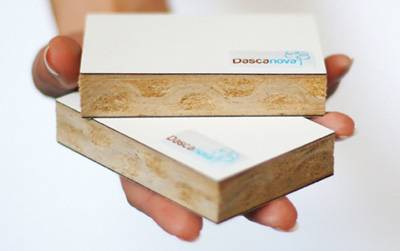
Utilizing a patent-pending technology, the Dascanova Co. introduced at Ligna 2011 a new panel product with a wave-like internal structure, resulting in an improved internal bond strength. The company said it received support for the development from a number of high-tech research funding agencies of the Austrian government.
Dascanova said it has been a two-year process to develop a number of various methods to change the density inside the particleboard or fiberboard into the wave-like structure. The company said it has seen a variety of benefits, including that the raw material costs for the panels can be reduced by up to 30 percent in the panel production, while achieving the same or better mechanical properties of standard panels on the market.
“The producer would gain advantage from lower production and transport costs as well as reduced environmental impact,” the company said in a statement. “The woodworking industry could use Dascanova products in the same way as standard wood based panel with the same fittings and connection elements. Moreover, the end user gets furniture with reduced weight and possible at lower price.”
 The Principle
The Principle
Dascanova said the theory behind its technology is similar to that of corrugated cardboard, where the waved structure of the middle paper layer makes the cardboard stronger than the paper sheets themselves. “Moreover, the final products of the Dascanova Technology do not have any air or hollow spaces, which improve the stability of the board regarding the physical influences, such as water condensation, and allow using standard woodworking machines,” the company said.
The Dascanova Technology modifies the compressibility of selected particles in the material before pressing the final board. This means that the technology can be used to produce the higher density in every section, versus solely on the surfaces.
One method for the one-press process is to use a system of heating sources for local pre-hardening of selected particle mass areas. The whole system is then synchronized with the material feed speed and the selected inner surface mat areas could be changed with an additional energy or liquid application (for local pre-hardening or full hardening).
According to the company, in the following step unmodified areas of the mat will be compressed significantly more, due to the loose substance of particles in comparison to the pre-hardened areas. During the final pressing step, the 3D arranged density structure is obtained. Dascanova said the ideal construction form is the triangular or wave structure.
Dascanova said the technology also can be used with existing lines, including continuous, multi-opening and contact presses, as well as for most any material or panel construction.
Although the technology to date has only been used in a lab setting, it should be available for testing on an actual production setting in 2012. Lab samples up to 40 cm, manufactured by various methods, have been produced.
According to Dascanova, research partners from Europe and North America, including Louisiana State University, ETH Zurich, BOKU Vienna and Technical University in Zvolen, Slovakia, have been participating in the research sub-projects. The Dascanova Co. also has been awarded with two international research prizes, Switzerland’s Collano Nolax Research Prize 2010 the Austria Josef-Umdasch Research Prize 2010.
The research and business development of the Dascanova Technology currently is being supported by the Austrian government high-tech funding agencies AWS Vienna, FFG Vienna and Tech2b Linz from Upper Austria.






Have something to say? Share your thoughts with us in the comments below.